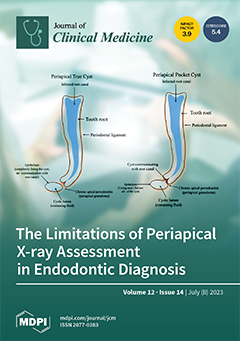Although previous studies investigated the influence of cardiovascular risk (CVR) factors in patients with acute coronary syndrome, data concerning the effect of CVR factors on the prognosis of patients with cardiogenic shock (CS) is scarce. Consecutive patients with CS were prospectively included from 2019 to 2021. The prognosis of patients with “low CVR” (i.e., 0–1 CVR factors) was compared to patients with “high CVR” (i.e., 2–4 CVR factors) according to presence or absence of arterial hypertension, diabetes mellitus, hyperlipidaemia or smoking. The primary endpoint was 30-day all-cause mortality. Statistical analyses included Kaplan-Meier and Cox proportional regression analyses. 273 consecutive patients with CS were included. 28% presented with low CVR and 72% with high CVR. Within the entire study cohort, the risk of 30-day all-cause mortality did not differ between patients with high and low CVR (55% vs. 57%; log rank
p = 0.727; HR = 0.942; 95% CI 0.663–1.338;
p = 0.738). Even after multivariable adjustment, high CVR was not associated with an elevated risk of 30-day all-cause mortality (HR = 1.039; 95% CI 0.648–1.667;
p = 0.873). The presence of arterial hypertension (55% vs. 58%; log rank
p = 0.564; HR = 0.906; 95% CI 0.638–1.287;
p = 0.582), diabetes mellitus (60% vs. 52%; log rank
p = 0.215; HR = 1.213; 95% CI 0.881–1.671;
p = 0.237) and a history of smoking (56% vs. 56%; log rank
p = 0.725; HR = 0.945; 95% CI 0.679–1.315;
p = 0.737) did not significantly influence short-term prognosis.. Only the absence of hyperlipidaemia significantly decreased the risk of all-cause mortality (65% vs. 51%; log rank
p = 0.038; HR = 0.718; 95% CI 0.516–0.998;
p = 0.049), which was no longer observed after multivariable adjustment (HR = 0.801; 95% CI 0.536–1.195;
p = 0.277). In conclusion, neither the overall CVR nor individual CVR factors were associated with the risk of 30-day all-cause mortality in patients with CS.
Full article






